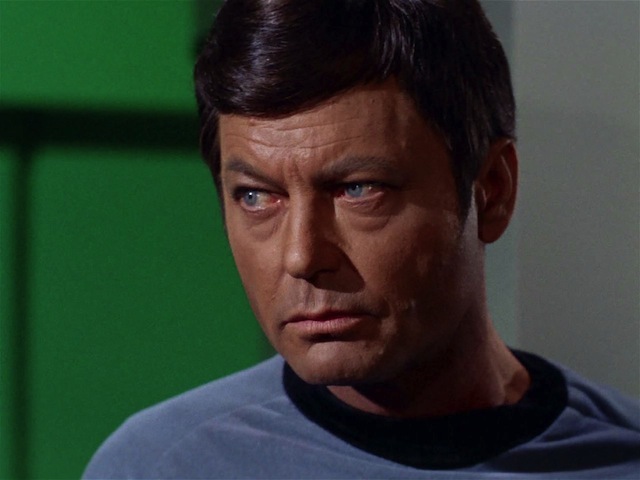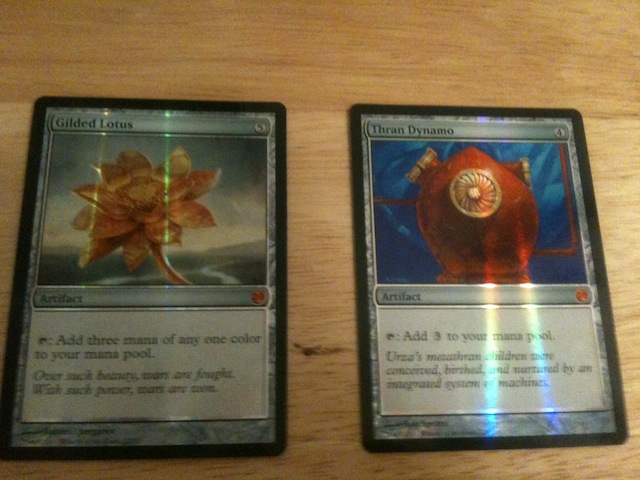Welcome back! If you like sweet draft decks, then this one’s for you. We Limited players have had an awesome run of draft formats lately. The last genuinely “bad” format was Avacyn Restored, and recent sets have had something for every taste. According to many serious draft aficionados, though, Modern Masters is one of the greatest draft formats of all time.
Local shop of awesomeness Twenty Sided Store recently ran a series of Modern Masters eight-person drafts. For prize support, each pod got to draft the cards of From the Vault: 20, using the draft results for seeding. I’m not a big fan of foils, but FTV20 has some sweet ones. Wouldn’t you like to own a foil Thran Dynamo? Or the new-art Fyndhorn Elves? That one’s a massive improvement on Ice Age’s weird Llanowar Pirates. There are also a number of more valuable and hard-to-get foils that you might have heard about. And in addition, you got to keep the MMA deck you drafted.
Now, I’m ambivalent on MMA’s place in the draft pantheon. It’s a fun set to draft for sure, but I have two big critiques.
I didn’t like the feel of drafting a limited-release set. I’d only played six drafts before this event—one paper and five online. The best draft formats, at least in my opinion, invite you to go deep and reward drafting dozens of times. You could theoretically do that in MMA for a few weeks while it was available online, but that was cost-prohibitive and not many people did. MMA might have been a format I’d love like no other if I were able to run it back 50 times, but its limited availability kept that from happening. I suspect a lot of others had a similar experience.
The execution of the archetypes feels forced as well. Each two-color pair has a deck, but those archetypes play similarly from draft to draft. The best formats should have viable strategies for each “guild” pair, but that should be the baseline rather than the ideal. In MMA, there are a few viable archetypes that offer flexibility and customization, my favorite being five-color green, but a lot of the time it’s just another goblins/thallids/giants/rebels/storm/affinity deck you are either playing or trying to beat. MMA is like a Cube in power level, but without the singleton limitation to impose diversity and creativity in deckbuilding.
Maybe Wizards of the Coast intentionally left MMA at this level of depth because they knew that limited availability would negate the value of giving the players a truly rich palette of archetypes to explore. The all-reprint limitation also works against subtle refinement. But regardless, as much fun as it is to draft and play Modern Masters, I don’t see how it can quite claim the title of best draft format of all time.
That said, I still snapped off a spot in the draft pod on Saturday, August 24. Hunter also played that draft and wrote about his special teams play. I made it to the finals and was one win away from owning my very own foil Jace, with two games to play, but I came up short. Bert Phillips took down the top prize skillfully and rebelliously, and Hunter pinned me at the five with a dagger of a kick to pass me on tiebreakers and claim second. It was still an awesome event.
The Draft
I sat down looking to draft five-color green, rebels, or a control deck with sweet bombs. That probably describes half or more of the pod, however, so I would go with the flow to see what was open.
I first-picked Riftwing Cloudskate. Suspend is one of the most broken Limited mechanics (extort says hi!) and blue is one of the most broken colors, so it’s a pick that lets me stay open. My next few picks in pack one were Tooth and Nail; Kira, Great Glass-Spinner; Epochrasite; Rude Awakening; and Traumatic Visions. That’s a good selection of cards without much focus. I’m happy to work with these and slot into an open archetype, and I love Traumatic Visions. The toughest pick was Kira, which I took over an Errant Ephemeron. I’m not sure if Kira is better, but it’s one of the most frustrating cards to play against so it’s probably the right pick.
Pack two, I opened a foil Pact of Negation. Zero mana counter? Sign me up! Then I got passed a Doubling Season. I had never played with this card before, but I had played against it in an online MMA draft. I got destroyed by approximately 200 small plants. My deck already had one Thallid and an Echoing Courage from pack one, so I decided ‘tis the season to be holly. I had to pass a Path to Exile, but that’s life. For the rest of the pack, I stocked up on the free-flowing thallids and a few green suspend cards.
The highlights from pack three were Kodama’s Reach, Errant Ephemeron, Aethersnipe, Masked Admirers, and Pallid Mycoderm. There are very few things in Magic that I like to do more than draw extra lands out of my deck, and Kodama’s Reach is one of my favorites. I never got removal, but the deck had enough proactive threats and just enough counter and bounce interaction to support the relentless saproling assault.
Double Decker
Building the deck was fairly straightforward. The trickiest part of playing the deck, I found, was sequencing your early plays. On turn two, do you cast a Thallid Shell-Dweller or suspend an Errant Ephemeron? Turn one Thallid or Durkwood Baloth? I think you generally want to start the clock on spore counters as soon as possible, but suspend is so strong.
Sideboarding is important in MMA because of the many powerful decks you can face. I had the Epochrasite to block intimidate creatures and grind extra value. Citanul Woodreaders is a good source of card draw, but I like Masked Admirers a little more as a cheaper threat that attacks and probably draws more cards. Rude Awakening is better as a finisher in a control deck. Cold-Eyed Selkie is great against one of the most powerful cards in Magic—the basic Island. A third Echoing Courage can help in combat-heavy matchups where I want to be able to use one early without losing the chance to win the game with it later. Dispeller’s Capsule is awkward to splash because you need two white mana to cast and use it on the same turn. Pyrite Spellbomb is a possible splash, but I will discuss that decision later.
MMA is a very complex format and some interesting card interactions come up in every game. This deck has a few tricky ones worth noting:
1. Doubling Season does not affect suspended cards. When you suspend a card, it is not a “permanent you control,” so it does not get double the time counters.
2. You can trigger Masked Admirers’ graveyard recursion from casting a creature when it comes off suspend, which is good because you have all your mana untapped to pay the GG. You cannot trigger Masked Admirers when you suspend a creature from your hand.
3. Kira, Great Glass-Spinner affects your spells too, so it is not great with Echoing Courage. It does not trigger, however, if your opponent uses a rebel searcher to fetch Bound in Silence, because the enchantment does not target when it gets put on the battlefield.
4. Pallid Mycoderm makes for some interesting combat math when you have a lot of saprolings. If you only attack with saprolings, you maximize power by sacrificing half, rounded down for odd numbers. For example, if you have seven tokens, sacrifice three to get four 4/4s for 16 power. If you sacrifice two, you get five 3/3s, and sacrificing four gives you three 5/5s, both for 15 power. Remember that Pallid Mycoderm’s sacrifice ability pumps your fungus creatures too (all your thallids) so if you are attacking or blocking with them as well, you get more value out of each sacrifice. And of course the math changes if your opponent is blocking.
One more note about playing a thallid deck: Bring a lot of dice and remember all your upkeep triggers.
The Games
Round one I faced Brian Lorenzen aka Meloku, the Clouded Mirror.

Brian was playing UW affinity with Meloku to end the long game. My deck was not great against fliers, with just the Ephemeron, Dustwasp, Kira, Cloudskate, and Kira to block them. (I really wanted a Penumbra Spider or two, but those were scooped up by David “Bones” McCoy to my left, who must have hit a run of them in pack two. Editor’s note: At one point, Dave had at least three Penumbra Spiders out against me, so—yeah. HRS)
Game one was a long and grinding affair. Brian played first and had a turn two Arcbound Stinger. I suspended an Ephemeron in response and started taking one in the air while I deployed Thallid Shell-Dwellers. On turn six I got the Ephemeron online, but Brian had Vedalken Dismisser to punish me. I kept all my spore counters back in hopes of drawing a Doubling Season that never came.
Eventually he played Meloku when I was at five life. I made a handful of saprolings and bounced Meloku with Cloudskate. He picked up four lands to make illusion tokens, and I was able to force some of them to block saprolings. Bounce is an effective short-term strategy against Meloku, as spending five to recast him limits the tokens to be made. I got to a turn where I had to send as many ground attackers as I could to force blocks with all the tokens, while holding my Ephemeron and Cloudskate back to block Meloku and a flier equipped with Bonesplitter. I “smartly” remembered I could attack with my Thallid as an extra 1/1. That seemed smart until I realized post-combat that I miscounted and Brian had lethal with his Frogmite and other ground dudes.
Game two I got Doubling Season online early and attacked often, fueled by a Pallid Mycoderm. It is hard to lose if you have Mycoderm and Doubling Season on board for a few turns. Game three, Brian mulled to five and was short on mana. I was able to beat down quickly and had Doubling Season back in case I couldn’t win early. Fortunately, my beatdown was enough and I was 1-0.
Round two I faced the Star Trek legend himself, Dr. Bones McCoy.
The good doctor was running a blue-green turtle shirt and a deck somewhat to match. He had gleefully snagged the Ephemeron I passed early in pack one, along with multiple copies of Search for Tomorrow and Penumbra Spider. I was in for some Skyreach Manta assaults and Etched Oracle card-drawing—plus whatever bombs he snagged.
Game one, again, was a grind. He was able to threaten my life total with a 4/4 Skyreach Manta, and later trade it for an Ephemeron, then play his own. At one point, I cycled my Sylvan Bounty to fetch a Plains. “Has anyone ever cast that to gain life?” Dave asked. Eventually he went for a big ground attack when we were both low on life. I had favorable blocks with my armies of fungi and small plants, but he had Gleam of Resistance. “Is that the one that gives them lifelink?” I asked. No, it’s the one that untaps them and gives +1/+2. Same difference, really, since I lost creatures and he had blockers to prevent my lethal attack. I was dead soon after.
Game two I was on the play and kept a doozy: Durkwood Baloth, Thallid Shell-Dweller, Sylvan Bounty, Doubling Season, Thallid, Echoing Courage, and Forest. I promptly suspended a Baloth, then cast a Thallid and missed my second land drop. Sylvan Bounty got me from two to three lands, where I stayed for a long time. But I managed to stay alive and eventually get Doubling Season on board, followed by a Sporoloth Ancient. Dave was putting on the pressure to kill me, including with the Skeletal Vampire, and sent in a big attack, taking me down to very low life. He was at 18 and kept back a handful of blockers to blunt my horde. At the end of the turn, I made 22 saproling tokens. I sent in with all the tokens plus my lone 1/1 Thallid. This time that decision favored me, as Dave had forgotten to count the Thallid when he left back blockers and I had exactly 18 unblocked 1/1s for the win.
Game three was similar, racing Doubling Season against his two Durkwood Baloths and an Aethersnipe. The ending was priceless. He passed the turn to me when I was at six life. End of turn I said, “I might as well do it,” and cast Sylvan Bounty to gain eight. Then I attacked with four saprolings and a Sporoloth Ancient. Dave was at eight. Three tokens got in unblocked so I cast Echoing Courage for the win. Dave then cast his own Sylvan Bounty, and I slammed Pact of Negation to win the match.
Round three I faced the Rebel Alliance, piloted by Bert Phillips.
Rebels are a bad matchup for Thallids because you will never, ever kill a rebel searcher. I had hoped nobody was drafting rebels because in pack two my 14th pick was between Echoing Courage and Saltfield Recluse (foil, no less). I don’t know what earth we live on where a Saltfield Recluse goes last pick. I guess this world, because I needed the Echoing Courage. Seriously, Saltfield Recluse is very powerful, and one of the best cards in the rebels archetype. Just my luck, Bert was to my right and got that Recluse. He told me after that he didn’t play that one because he had two others that weren’t foil. And, strangely enough, it would not matter, as Bert only searched up a rebel once in the entire match. You’d think that would be good for me.
Game one he kept a speculative hand with a Blightspeaker and three lands. I played creatures and attacked. He had to chump with the Blightspeaker to buy a turn, then drew his fourth land in time to die. I kind of wished the game went longer, so I could see what to sideboard against, but a quick win is always welcome. I ended up siding in Citanul Woodreaders to get extra card draw, but maybe I should have brought in Pyrite Spellbomb and a Mountain. At the time, though, being able to kill one small creature did not seem worth screwing with my mana, which was already a bit precarious. I need a lot of Forests for my early plays and enough Islands to get early suspend and play my UU cards. Even though I have a Vivid land, two landcyclers and Kodama’s Reach, I didn’t think I could afford to put in a Mountain. Maybe I was wrong.
Game two was long and—guess what—grindy. Bert never played a searcher, but eventually drew and played Amrou Seekers and put me on a ten-turn clock. My only answers to it (other than the Spellbomb and Epochrasite in my board) were Pallid Mycoderm to block, and bounce to slow it down. I didn’t have Doubling Season, so my pressure was slower. At one point I had Echoing Courage and Aethersnipe left in hand and Bert played Tidehollow Sculler. I’d already used my first Courage to kill a Saltfield Recluse in combat, but he can play around that. Aethersnipe was more important to buy me time by bouncing the Seekers, and that’s what he took. That Sculler never blocked. A Kitchen Finks and Blinding Beam were enough to stall me while the Seekers did all 20 damage. At two life, I tapped my library hoping to draw Mycoderm or Sylvan Bounty, but it was Traumatic Visions instead.
Game three I sided in the Epochrasite. I kept a speculative hand with three Forests, Vivid Creek, Durkwood Baloth, Doubling Season, and Imperiosaur. Bert played turn-two Amrou Scout, turn-three Amrou Seekers, turn-four evoked Meadowboon to pump them both, and just beat me down quickly and painfully. I stupidly forgot the basic-land drawback on Imperiosaur and played turn two Vivid Creek, and then could not put out Imperiosaur to block on turn four. I drew all lands, and when I finally got the Baloth and Imperiosaur online Bert had Flickerwisp to bounce a blocker for a turn. “That’s game,” I said, and it was.
I congratulated Bert on his victory, which was well deserved. It really came down to game two, but he took the lines necessary to win that game. His decision to evoke Meadowboon and go for the quick kill was also very good. He could see I kept a slow hand (which I probably should have mulliganed) and took initiative.
As I said above, I ended up 2-1 and third place on tiebreakers after Hunter beat Dave to get to 2-1 as well. It was a little disappointing, but I lost fair and square. Plus, I still got two of the sweeter cards in FTV20:
Who doesn’t love artifacts that tap for three mana?
Carrie O’Hara is Editor-in-Chief of Hipsters of the Coast.




